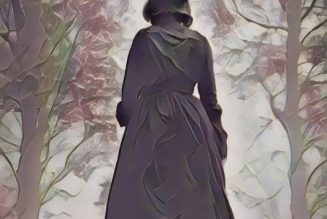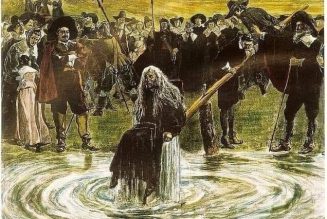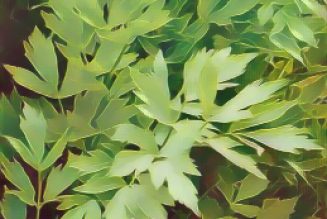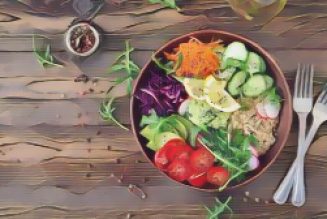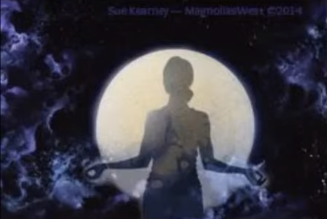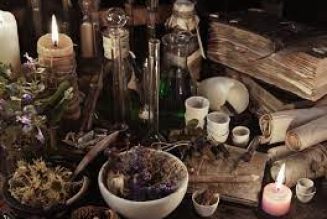In Witchcraft, the gods are often seen as a part of nature, as are we, flowing through time and space.
That quality, that energy that we term as the deity is within everything.
As it is within everything, nothing is better than anything else.
There is inherent animism within Witchcraft, insomuch as we know that one thing is not better than another, that everything has its own inherent value.
It is something that we work with every day, coming up against our own notions of value, where we place the boundaries of our knowledge and experience upon the world.
When we have lost sight of the sacred, we look to other distractions in order to stave off the fear and longing of self-imposed separation.
The gods are energy; the gods are immanent.
They take on whatever form they wish, or whatever form we feel we are best able to communicate with and establish a relationship in order to learn and understand.
The gods may hold more power in certain regards than we do; for example, as a thunderstorm raging across the landscape may hold
terrible power, causing floods and damage to many homes, both human and other than human.
But we also have that power within ourselves, the tides that flood through us, our capacity for creation and destruction.
We simply act upon those tides to create harmony within our ecosystem as much as we can, for that is the purpose of the Hedge Witches Craft.
The earth knows what She is doing, and so storms and earthquakes happen.
The earth, as all beings are, is constantly seeking homeostasis, the balance point.
We can see the destruction of the storm, but we can also see the need for that storm to have happened, the part that we played in causing it, such as through global warming and climate change.
Though the gods may appear terrible and mighty, they are not better than us, just different.
Equally, the world over has deities of love and compassion, of empathy and peace.
These deities are not better than us, but serve as an example of how we too can work with their energy in order to create a harmonious union with everything around us.
Just as we don’t hold a person or a celebrity higher than ourselves simply because they exist, neither do we do so for any deity.
We are simply working with them, using the notion of co-operation and co-existence in order to live our lives in service to our Craft.
It may be important that we learn how to be in the world without losing our power, our autonomy.
All too readily we are willing to give authority and power over to a teacher, a celebrity, a god, and in doing so we are doing a disservice to ourselves.
It’s fine to respect people for what they say and more importantly for what they do, but we must also learn to stand on our own two feet and be the light that we want to see in the world.
Often when we meet people we admire, we lose ourselves: we forget our own inherent self-worth.
Just because someone has something to say, perhaps even something important, doesn’t make them better than you.
Just because someone knows more things than you do, doesn’t make them better than you.
We all know different things. Just because someone has had life experience, doesn’t make them better than you.
A child is just as important as an octogenarian.
In basic, it may be an idea not to give up your power to anyone.
Admire them, sure, respect them, but do not place them on any sort of pedestal.
This includes the Gods.
But what makes a god, a god?
How can we differentiate between something that is, say, the sidhe or fairy, or a spirit of place, from a god?
We, humans, are always so keen to label things, to put them in boxes, but really we need to do this to an extent in order to grasp some
concepts that at first may seem far too large to handle.
If we look at the spirits of place, this is the energy of a location.
It is also viewed as the energy of the land, the sea or the sky.
There is often a fine distinction between a god and the spirit of place, and that line can move about from entity to entity.
Divinity or deity is a force of nature that has the power to kill.
Therefore, a river, a storm, a flood, the sun, the process of birthing and dying: these are all gods.
They are all a part of nature.
There are also gods of human nature as well: gods of lust and rage, love and ecstasy.
For me, I feel this definition is still too limited; I feel that deity is something which operates on a much grander scale, whether or not it has the capacity to kill us.
So, I honour the spirits of place where I live, but the over-arching energy that holds it all together, say, the heathland in its entirety as delineated by natural boundaries, is to me a god.
The forest that lies to the north of the heathland is, to me, a god.
It would be difficult for the heath or forest to kill me; I might get bitten by an adder if I am not careful walking about in the sunshine, but the adder is simply a part of that greater energy, and not the energy itself.
Perhaps we can even see human beings as being a part of the greater energy of a god, or God if you want to use a capital “G”.
My teacher later described god as nature, and that, I think, hits closer to the mark for me.
It is more the path of the mystic, to be sure, but it still encompasses the feeling that God or the gods are something other than ourselves, bigger than ourselves, but still comprised of ourselves.
Ascribing gender to a god is yet another way for the human mind to grasp such a large concept as a god or a goddess, and is all part of
helping us to relate that power, to that energy.
Maybe one day we will lose the idea of gender altogether, in society and in relation to the gods.It’s a personal thing. In my work, some gods of the gods I work with have no gender, such as the god of the heathland.
I’m not sure if the forest has a gender.
But my lady Brighid I see as female.
It might be concerned with having ancestral gods, as well as finding out the gods of your own locality.
With ancestral, named gods, we are using all the past associations that have come with them through the mists of time.
We are also perhaps giving them new associations.
Brighid, for me, can also be seen as the goddess of technology, the spark of electricity.
Because she has been seen as a woman for thousands of years, I find that I can reach back through my own human heritage to know her as such, as my ancestors did thousands of years ago.
But really, when it all comes down to it, she is simply energy.
Much as we are.
Everything that exists and has ever existed is simply energy-given form.
Some we see, some we can’t.
We know the power and energy that the wind has, but we cannot see it; we can only see its effects on the environment.
When it comes to beings such as humans, or other animals, we know that we are comprised of countless atoms bouncing off each
other, moving and creating energy, that spirals upwards in layers of energy bound to a manifest form.
The table in front of me is energy-given form.
Though I can’t see that energy, what gives the table its solidity is the fact that atoms moving around are sustaining the manifest
form that I know as “wood”.
We also know that energy moves through things as well, through “solid” things.
There are atoms that can move through this table, through walls, through the human body.
Physics is a wonderful way to realise the true interconnectedness of all life.
So, for me, the gods are a collection of energy that is larger than the spirits of place, yet made up of the spirits of place.
It is a powerful energy that we can connect to.
If we look at it from a monist perspective, nature is god and god is nature.
That simplifies things to an extent, but may make it harder to relate to as it operates on such a grand scale.
That is why we have polytheists, those who work with many separate gods in Witchcraft, as well as monists.














